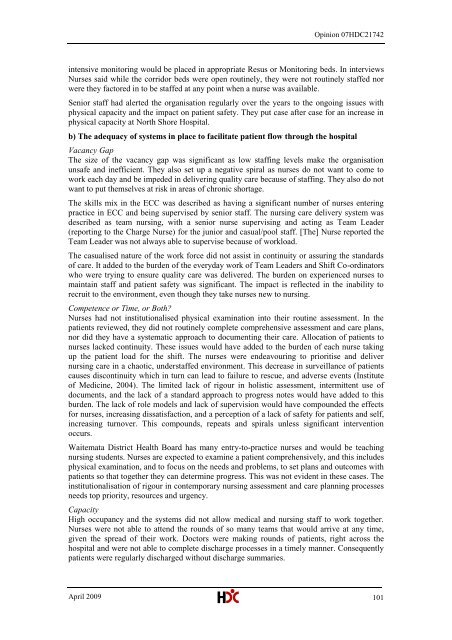North Shore Hospital report - New Zealand Doctor
North Shore Hospital report - New Zealand Doctor
North Shore Hospital report - New Zealand Doctor
Create successful ePaper yourself
Turn your PDF publications into a flip-book with our unique Google optimized e-Paper software.
Opinion 07HDC21742intensive monitoring would be placed in appropriate Resus or Monitoring beds. In interviewsNurses said while the corridor beds were open routinely, they were not routinely staffed norwere they factored in to be staffed at any point when a nurse was available.Senior staff had alerted the organisation regularly over the years to the ongoing issues withphysical capacity and the impact on patient safety. They put case after case for an increase inphysical capacity at <strong>North</strong> <strong>Shore</strong> <strong>Hospital</strong>.b) The adequacy of systems in place to facilitate patient flow through the hospitalVacancy GapThe size of the vacancy gap was significant as low staffing levels make the organisationunsafe and inefficient. They also set up a negative spiral as nurses do not want to come towork each day and be impeded in delivering quality care because of staffing. They also do notwant to put themselves at risk in areas of chronic shortage.The skills mix in the ECC was described as having a significant number of nurses enteringpractice in ECC and being supervised by senior staff. The nursing care delivery system wasdescribed as team nursing, with a senior nurse supervising and acting as Team Leader(<strong>report</strong>ing to the Charge Nurse) for the junior and casual/pool staff. [The] Nurse <strong>report</strong>ed theTeam Leader was not always able to supervise because of workload.The casualised nature of the work force did not assist in continuity or assuring the standardsof care. It added to the burden of the everyday work of Team Leaders and Shift Co-ordinatorswho were trying to ensure quality care was delivered. The burden on experienced nurses tomaintain staff and patient safety was significant. The impact is reflected in the inability torecruit to the environment, even though they take nurses new to nursing.Competence or Time, or Both?Nurses had not institutionalised physical examination into their routine assessment. In thepatients reviewed, they did not routinely complete comprehensive assessment and care plans,nor did they have a systematic approach to documenting their care. Allocation of patients tonurses lacked continuity. These issues would have added to the burden of each nurse takingup the patient load for the shift. The nurses were endeavouring to prioritise and delivernursing care in a chaotic, understaffed environment. This decrease in surveillance of patientscauses discontinuity which in turn can lead to failure to rescue, and adverse events (Instituteof Medicine, 2004). The limited lack of rigour in holistic assessment, intermittent use ofdocuments, and the lack of a standard approach to progress notes would have added to thisburden. The lack of role models and lack of supervision would have compounded the effectsfor nurses, increasing dissatisfaction, and a perception of a lack of safety for patients and self,increasing turnover. This compounds, repeats and spirals unless significant interventionoccurs.Waitemata District Health Board has many entry-to-practice nurses and would be teachingnursing students. Nurses are expected to examine a patient comprehensively, and this includesphysical examination, and to focus on the needs and problems, to set plans and outcomes withpatients so that together they can determine progress. This was not evident in these cases. Theinstitutionalisation of rigour in contemporary nursing assessment and care planning processesneeds top priority, resources and urgency.CapacityHigh occupancy and the systems did not allow medical and nursing staff to work together.Nurses were not able to attend the rounds of so many teams that would arrive at any time,given the spread of their work. <strong>Doctor</strong>s were making rounds of patients, right across thehospital and were not able to complete discharge processes in a timely manner. Consequentlypatients were regularly discharged without discharge summaries.April 2009 101
















